Applied Linear Statistical Models, Part 2 - Class Notes
From Applied Linear Statistical Models, by Michael Kutner, Christopher Nachtsheim, John Neter, and William Li (McGraw Hill, 2005)

Copies of the classnotes are on the internet in PDF format as given below. The notes and supplements may contain hyperlinks to posted webpages; the links appear in red fonts. The "Proofs of Theorems" files were prepared in Beamer. The "Printout of Proofs" are printable PDF files of the Beamer slides without the pauses. These notes have not been classroom tested and may have typographical errors.
"Applied Linear Statistical Models" is not a formal class at ETSU, but the material here might overlap some with the Statistical Methods sequence (STAT 5710 and 5720). The book and these notes are broken into six parts. Links to the parts are given on my main Applied Linear Statistical Models webpage.
PART TWO. MULTIPLE LINEAR REGRESSION
Chapter 6. Multiple Regression I.
- 6.1. Multiple Regression Models.
- 6.2. General Linear Regression Model in Matrix Terms.
- 6.3. Estimation of Regression Coefficients.
- 6.4. Fitted Values and Residuals.
- 6.5. Analysis of Variance Results.
- 6.6. Inferences about Regression Parameters.
- 6.7. Estimation of Mean Response and Prediction of New Observation.
- 6.8. Diagnostics and Remedial Measures.
- 6.9. An Example - Multiple Regression with Two Predictor Variables.
- Study Guide 6.
Chapter 7. Multiple Regression II.
- 7.1. Extra Sums of Squares.
- 7.2. Uses of Extra Sums of Squares in Tests for Regression Coefficients.
- 7.3. Summary of Tests Concerning Regression Coefficients.
- 7.4. Coefficients of Partial Determination.
- 7.5. Standardized Multiple Regression Model.
- 7.6. Multicollinearity and Its Effects.
- Study Guide 7.
Chapter 8. Regression Models for Quantitative and Qualitative Predictors.
- 8.1. Polynomial Regression Models.
- 8.2. Interaction Regression Models.
- 8.3. Qualitative Predictors.
- 8.4. Some Considerations in Using Indicator Variables.
- 8.5. Modeling Interactions between Quantitative and Qualitative Predictors.
- 8.6. More Complex Models.
- 8.7. Comparison of Two or More Regression Functions.
- Study Guide 8.
Chapter 9. Bulding the Regression Model I: Model Selection and Validation.
- 9.1. Overview of Model-Building Process.
- 9.2. Surgical Unit Example.
- 9.3. Criteria for Model Selection.
- 9.4. Automatic Search Procedures for Model Selection.
- 9.5. Some Final Comments on Automatic Model Slection Procedure.
- 9.6. Model Validation.
- Study Guide 9.
Chapter 10. Building the Regression Model II: Diagnostics.
- 10.1. Model Adequacy for a Predictor Variable - Added Variable Plots.
- 10.2. Identifying Outlying Y Observations - Studentized Deleted Residuals.
- 10.3. Identifying Outlying X Observations - Hat Matrix Leverage Values.
- 10.4. Identifying Influential Cases - DFFITS, Cook's Distance, and DFBETAS.
- 10.5. Multicollinearity Diagnostics - Variance Inflation Factor.
- 10.6. Surgical Unit Example - Continued Cited References.
- Study Guide 10.
Chapter 11. Building the Regression Model III: Remedial Measures.
- 11.1. Unequal Error Variances Remedial Measures - Weighted Least Squares.
- 11.2. Multicollinearity Remedial Measures - Ridge Regression.
- 11.3. Remedial Measures for Influential Cases - Robust Regression.
- 11.4. Nonparametric Regression: Lowess Method and Regression Trees.
- 11.5. Remedial Measures for Evaluating Precision in Nonstandard Situations - Bootstrapping.
- 11.6. Case Example - MNDOT Traffic Estimation.
- Study Guide 11.
Chapter 12. Autocorrelation in Time Series Data.
- 12.1. Problems of Autocorrelation.
- 12.2. First-Order Autoregressive Error Model.
- 12.3. Durbin-Watson Test for Autocorrelation.
- 12.4. Remedial Measures for Autocorrelation.
- 12.5. Forecasting with Autocorrelated Error Terms.
- Study Guide 12.
Return to Bob Gardner's home page

